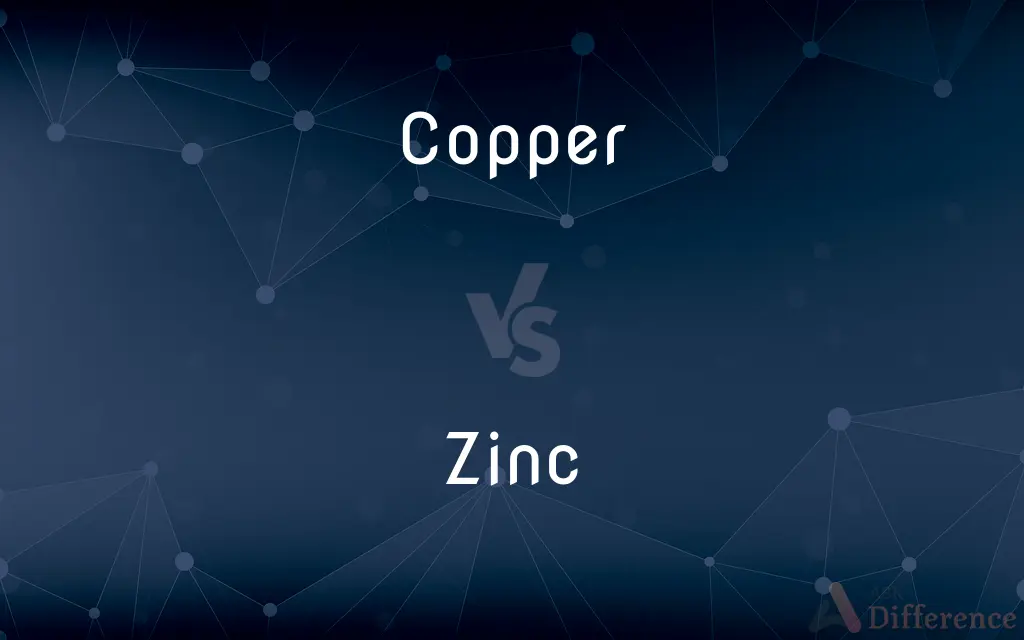Copper vs. Zinc — What's the Difference?
By Maham Liaqat & Fiza Rafique — Updated on April 2, 2024
Copper is a highly conductive, malleable metal used in electrical wiring and plumbing, while zinc is less conductive, primarily used for galvanizing iron and steel to prevent rust.

Difference Between Copper and Zinc
Table of Contents
ADVERTISEMENT
Key Differences
Copper, known for its reddish-brown color and excellent electrical conductivity, is widely used in electrical wiring, electronics, and plumbing. Zinc, on the other hand, is primarily known for its ability to protect other metals from corrosion through galvanization.
In terms of environmental impact, both metals are recyclable, but copper's high value encourages more recycling efforts. Zinc, while also recyclable, is often recovered as a byproduct of processing other metals, highlighting different approaches to sustainability between the two.
Copper's historical significance stretches back thousands of years, utilized by ancient civilizations for tools, ornaments, and as a medium for art. Zinc was identified as a distinct metal in the 18th century, though its compounds have been used for millennia, notably in alloys such as brass.
Economically, copper is more valuable per unit weight, reflecting its widespread use in essential technologies and renewable energy systems. Zinc's economic value is tied to its role in infrastructure and manufacturing, demonstrating how both metals are indispensable to modern industry and technology.
Comparison Chart
Conductivity
High electrical and thermal conductivity
Lower electrical and thermal conductivity
ADVERTISEMENT
Primary Use
Electrical wiring, electronics, plumbing
Galvanizing metals, alloys, supplements
Malleability
Highly malleable
Less malleable than copper
Historical Use
Tools, ornaments, currency
Brass alloys, medicinal uses
Economic Value
Higher due to demand in tech and energy
Lower, but crucial for infrastructure
Environmental Role
Highly recyclable, encourages conservation
Recyclable, often recovered as a byproduct
Health Importance
Antimicrobial properties
Essential for immune function, enzyme activity
Compare with Definitions
Copper
An element essential for bodily functions but toxic in excess.
Copper is important for blood vessel formation.
Zinc
Essential for human health, involved in various enzymes.
Zinc supplements are often recommended to support the immune system.
Copper
A ductile, malleable metal with high electrical conductivity.
Copper wires are used extensively in electrical wiring due to their conductivity.
Zinc
Used in making alloys like brass.
Zinc is combined with copper to produce brass instruments.
Copper
A reddish-brown metal used in coins and decorations.
The statue was made of copper, giving it a distinctive hue.
Zinc
A bluish-white metal used to galvanize steel.
Zinc coating prevents rust on steel structures.
Copper
A metal valued for its recycling potential.
Recycled copper retains its quality and is widely used in various industries.
Zinc
Found in batteries and other industrial applications.
Zinc is used in the anode of alkaline batteries.
Copper
Used for antimicrobial applications.
Copper surfaces in hospitals help reduce the spread of infections.
Zinc
Recyclable, with a significant role in sustainable practices.
Zinc recycling is crucial for reducing environmental impact.
Copper
Copper is a chemical element with the symbol Cu (from Latin: cuprum) and atomic number 29. It is a soft, malleable, and ductile metal with very high thermal and electrical conductivity.
Zinc
Zinc is a chemical element with the symbol Zn and atomic number 30. Zinc is a slightly brittle metal at room temperature and has a silvery-greyish appearance when oxidation is removed.
Copper
Symbol Cu A ductile, malleable, reddish-brown metallic element that is an excellent conductor of heat and electricity and is widely used for electrical wiring, water piping, and corrosion-resistant parts, either pure or in alloys such as brass and bronze. Atomic number 29; atomic weight 63.546; melting point 1,085°C; boiling point 2,562°C; specific gravity 8.96; valence 1, 2. See Periodic Table.
Zinc
A bluish-white, lustrous metallic element that is brittle at room temperature but malleable with heating. It is used to form a wide variety of alloys including brass, bronze, various solders, and nickel silver, in galvanizing iron and other metals, for electric fuses, anodes, meter cases and batteries, and in roofing, gutters, and various household objects. US pennies minted after 1982 consist of a copper-clad zinc core. Atomic number 30; atomic weight 65.38; melting point 419.53°C; boiling point 907°C; specific gravity 7.134 (at 25°C); valence 2. See Periodic Table.
Copper
A coin, usually of small denomination, made of copper or a copper alloy.
Zinc
To coat or treat with zinc; galvanize.
Copper
Chiefly British A large cooking pot made of copper or often of iron.
Zinc
A chemical element (symbol Zn) with an atomic number of 30, a slightly brittle blue-silvery metal.
Copper
Any of various small butterflies of the subfamily Lycaeninae, having predominantly copper-colored wings.
Zinc
(countable) A single atom of this element.
Copper
A reddish brown.
Zinc
(Nigeria) A corrugated iron roof.
Copper
A police officer.
Zinc
A zinc countertop.
Copper
To coat or finish with a layer of copper.
Zinc
(rare) To electroplate with zinc.
Copper
(Slang) To bet against, as in faro.
Zinc
(rare) To coat with sunblock incorporating zinc oxide.
Copper
(uncountable) A reddish-brown, malleable, ductile metallic element with high electrical and thermal conductivity, symbol Cu, and atomic number 29.
Zinc
An abundant element of the magnesium-cadmium group, extracted principally from the minerals zinc blende, smithsonite, calamine, and franklinite, as an easily fusible bluish white metal, which is malleable, especially when heated. It is not easily oxidized in moist air, and hence is used for sheeting, coating galvanized iron, etc. It is used in making brass, britannia, and other alloys, and is also largely consumed in electric batteries. Symbol Zn. Atomic number 30. Atomic weight 65.38.
Copper
The reddish-brown colour/color of copper.
Zinc
To coat with zinc; to galvanize.
Copper
Any of various specialized items that are made of copper, where the use of copper is either traditional or vital to the function of the item.
Zinc
A bluish-white lustrous metallic element; brittle at ordinary temperatures but malleable when heated; used in a wide variety of alloys and in galvanizing iron; it occurs as zinc sulphide in zinc blende
Copper
(countable) A copper coin, typically of a small denomination, such as a penny.
Copper
A large pot, often used for heating water or washing clothes over a fire. In Australasia at least, it could also be a fixed installation made of copper, with a fire underneath and its own chimney. Generally made redundant by the advent of the washing machine.
Mum would heat the water in a copper in the kitchen and transfer it to the tin bath.
I explain that socks can’t be boiled up in the copper with the sheets and towels or they shrink.
Copper
(entomology) Any of various lycaenid butterflies with copper-coloured upperwings, especially those of the genera Lycaena and Paralucia.
Copper
A police officer.
Copper
Made of copper.
Copper
Having the reddish-brown colour/color of copper.
Copper
To sheathe or coat with copper.
Copper
A common metal of a reddish color, both ductile and malleable, and very tenacious. It is one of the best conductors of heat and electricity. Symbol Cu. Atomic weight 63.3. It is one of the most useful metals in itself, and also in its alloys, brass and bronze.
Copper
A coin made of copper; a penny, cent, or other minor coin of copper.
My friends filled my pockets with coppers.
Copper
A vessel, especially a large boiler, made of copper.
Copper
The boilers in the galley for cooking; as, a ship's coppers.
All in a hot and copper sky.
Copper
To cover or coat with copper; to sheathe with sheets of copper; as, to copper a ship.
Copper
A ductile malleable reddish-brown corrosion-resistant diamagnetic metallic element; occurs in various minerals but is the only metal that occurs abundantly in large masses; used as an electrical and thermal conductor
Copper
A copper penny
Copper
Uncomplimentary terms for a policeman
Copper
A reddish brown the color of polished copper
Copper
Any of various small butterflies of the family Lycaenidae having copper colored wings
Copper
Coat with a layer of copper
Common Curiosities
What is the main use of zinc?
Primarily for galvanizing steel and iron to prevent corrosion.
How do copper and zinc differ in their applications?
Copper is mainly used in electrical applications and plumbing, while zinc is used for galvanizing and in alloys.
Can copper and zinc be recycled?
Yes, both metals are recyclable and retain their properties after recycling.
Why is zinc important for health?
It plays a vital role in immune function, wound healing, and enzyme activity.
Are copper and zinc found naturally?
Yes, both metals are found in the Earth's crust and obtained through mining.
Why is copper considered antimicrobial?
Copper ions disrupt microbial cell membranes, effectively killing or inhibiting the growth of bacteria.
Why is copper used in electrical wiring?
Due to its high electrical conductivity, making it efficient for transmitting electricity.
Can zinc replace copper in electrical applications?
No, because zinc's electrical conductivity is lower than copper's, making it less suitable for such uses.
Can excessive intake of copper or zinc be harmful?
Yes, while both are essential, excessive intake can lead to health issues, highlighting the need for balanced consumption.
Is copper or zinc more valuable?
Copper is generally more valuable due to its wide range of applications in essential technologies.
What role do copper and zinc play in renewable energy?
Copper is crucial in renewable energy systems, especially in solar and wind technologies, while zinc is used in batteries and energy storage solutions.
How are copper and zinc used in health supplements?
Copper is used in smaller amounts for its essential biological functions, whereas zinc is used to support the immune system and metabolic functions.
How do the melting points of copper and zinc compare?
Zinc has a lower melting point than copper, affecting their respective uses in industry.
What historical uses do copper and zinc have?
Copper has been used for tools and currency, while zinc compounds have been used in brass and medicinal creams.
How do copper and zinc contribute to sustainability?
Both metals are recyclable and play roles in sustainable practices, though copper's high value encourages more recycling efforts.
Share Your Discovery

Previous Comparison
Student vs. Trainee
Next Comparison
Indemnity vs. WarrantyAuthor Spotlight
Written by
Maham LiaqatCo-written by
Fiza RafiqueFiza Rafique is a skilled content writer at AskDifference.com, where she meticulously refines and enhances written pieces. Drawing from her vast editorial expertise, Fiza ensures clarity, accuracy, and precision in every article. Passionate about language, she continually seeks to elevate the quality of content for readers worldwide.
















































